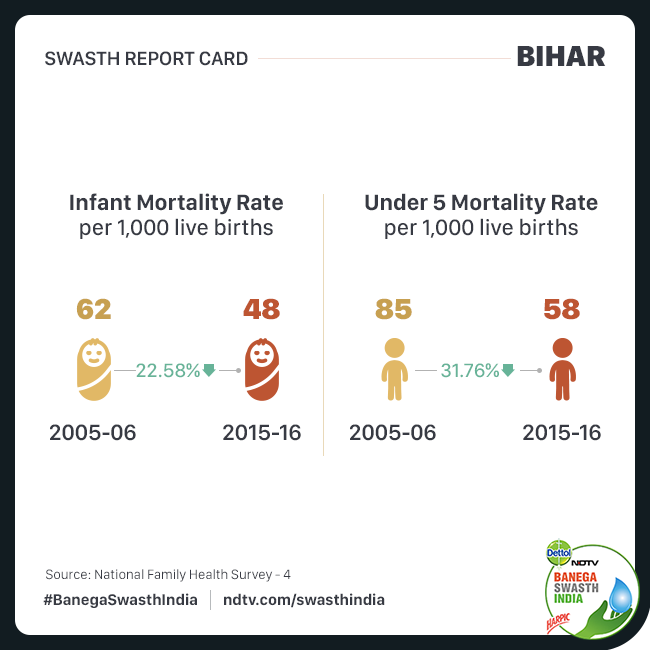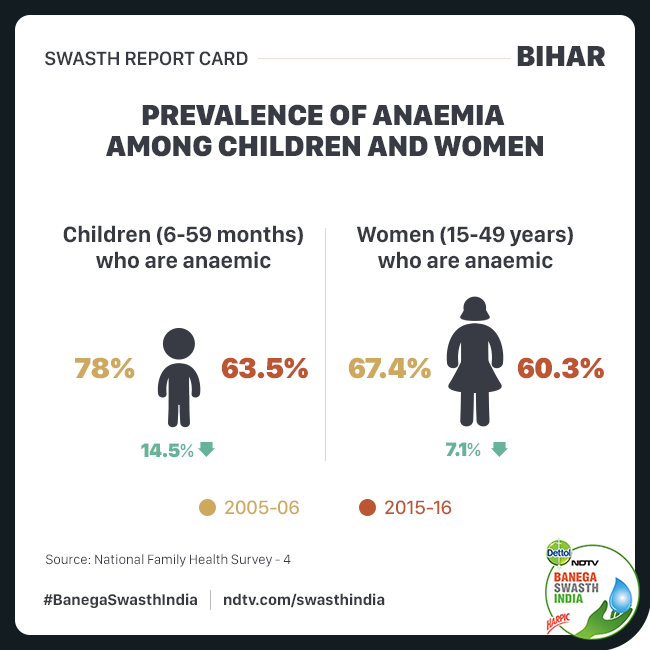New Delhi: Bihar, the state with the third-largest population in India, is one of the eight Empowered Action Group (EAG) states. The EAG states are the socioeconomically backward states that lag behind in the demographic transition and have the highest infant mortality rates in the country. Moreover, as per the Niti Aayog’s health index report titled “Healthy States, Progressive India”, the state is also one of the worst performing state, scoring just a few more points than Uttar Pradesh.
The report attributed the decline in the overall Health Index score of Bihar between the base year (2015-16) and the reference year (2015-16) to the deterioration of performances of several indicators.
In Bihar, the deterioration between the base year (2015-16) and the reference year (2017-18) was primarily due to the performance related to total fertility rate, low birth weight, sex ratio at birth, TB (tuberculosis) treatment success rate, quality accreditation of public health facilities, the report said.
Also Read: Banega Swasth India: Nutrition Experts Weigh In On The Crisis Of Malnutrition In India
Here’s a quick look at Bihar’s performance in terms of the various health indicators:
- Infant Mortality Rate: According to National Family Health Survey (NFHS) 4, the infant mortality rate (deaths before the age of one year) in Bihar was down to 48 per 1,000 live births IN 2015-16 from 62 per 1,000 live births in the NFHS-3 (2005-2006), a drop of 22.58 per cent. This drop is less than the 28 per cent drop seen at an all India level during the same period, from an IMR of 57 in 2005-06 to 41 in 2015-16.
- Under-Five Mortality Rate (U5MR): Bihar’s under-five mortality rate (children dying under the age of five), as per NFHS 4, stood at 58 per 1,000 live births, which came down by about 31.7 per cent from 85 per 1,000 live births in NFHS 3 (2005-06). This drop is again less than the drop seen at the national level of 32.4, 50 per 1,000 live births 2015-16, from 74 per 1,000 live births in 2005-06.
- Malnutrition: According to NFHS 4, Bihar has seen a 7.3 per cent drop in cases of stunting of children under 5 years. The figures, as of 2015-16, stand at 48.3 per cent, down from 55.6 per cent in 2005-06, during NFHS 3. At national level the drop in stunting was close to 10 per cent (9.6 per cent) to 38.4 per cent in 2015-2016 from 48 per cent in 2005-06. The state has also witnessed a decline of 12 per cent in the cases of children under 5 years who are underweight (low weight-for-age) – from 55.9 per cent (2005-06) to 43.9 per cent (2015-16), as per the NFHS 4. In this parameter Bihar has done better than the country in terms of achieving a higher drop in percentage than the 6.7 percent drop seen at an all India level between 2005-06 and 2015-16. But Bihar lags behind the country in the percentage of prevalent cases of underweight among the children surveyed, as at an all India level, 35.8 per cent in (2015-16) of the children under 5 surveyed were found to be underweight in 2015-16 (in Bihar it is 43.9 per cent) down from 42.5 per cent (in 2005-06) . When it comes to the wasting (low weight for height), Bihar stood at 20.8 per cent of the children surveyed in NFHS 4 who were found to be stunted down from 27.1 per cent in NFHS 3. In comparison at an all India level, wasting cases were at 21 per cent in NFHS 4 vis-à-vis 19.8 per cent in NFHS 3.
- Anaemia Among Children And Women: Bihar saw a 14.5 per cent decline in Anaemia cases for children from 78 per cent in 2005-2006 to 63.5 per cent IN 2015-16 (NFHS-4). When it comes to the women aged 15-49, the state saw a minor decline of 7.1 per cent, from 67.4 per cent to 60.3 per cent in the same period. At the national level anaemia stands at 10.8 per cent (children) and 2.2 per cent (women).
- Diarrhoea Cases And Death: According to National Health Profile 2019 report, Diarrhoeal disease deaths in Bihar in 2017 stood at 19 whereas in 2018 it came down to 9 deaths. Moreover, out of the total of over 1.3 crore (1,31,94,775) cases of Diarrhoea in India in 2018, Bihar contributed (12.75) per cent with almost 3 lakh cases (2,74,792) diarrhoea cases which is less than the 3,09,855 cases in 2017.
Also Read: Obesity Rates Soar Due To Dramatic Global Diet Shift: Food And Agriculture Organisation


































